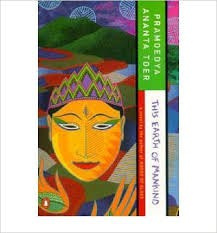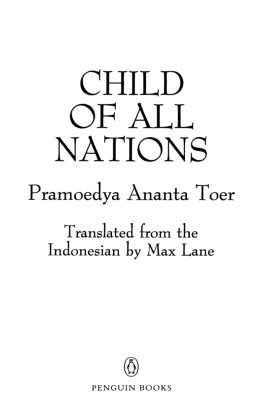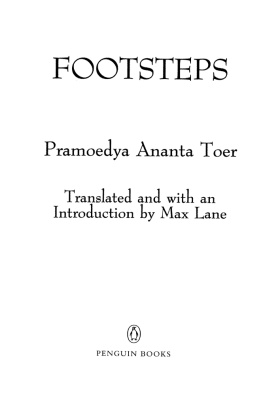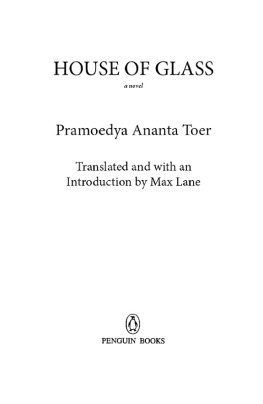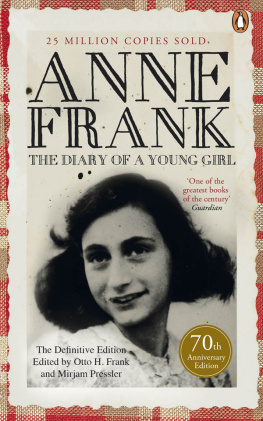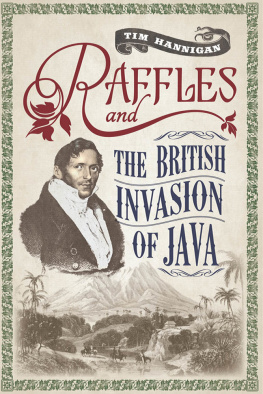Pramoedya Ananta Toer - This Earth of Mankind
Here you can read online Pramoedya Ananta Toer - This Earth of Mankind full text of the book (entire story) in english for free. Download pdf and epub, get meaning, cover and reviews about this ebook. year: 1996, publisher: Penguin Books, genre: Art. Description of the work, (preface) as well as reviews are available. Best literature library LitArk.com created for fans of good reading and offers a wide selection of genres:
Romance novel
Science fiction
Adventure
Detective
Science
History
Home and family
Prose
Art
Politics
Computer
Non-fiction
Religion
Business
Children
Humor
Choose a favorite category and find really read worthwhile books. Enjoy immersion in the world of imagination, feel the emotions of the characters or learn something new for yourself, make an fascinating discovery.
- Book:This Earth of Mankind
- Author:
- Publisher:Penguin Books
- Genre:
- Year:1996
- Rating:5 / 5
- Favourites:Add to favourites
- Your mark:
- 100
- 1
- 2
- 3
- 4
- 5
This Earth of Mankind: summary, description and annotation
We offer to read an annotation, description, summary or preface (depends on what the author of the book "This Earth of Mankind" wrote himself). If you haven't found the necessary information about the book — write in the comments, we will try to find it.
This Earth of Mankind — read online for free the complete book (whole text) full work
Below is the text of the book, divided by pages. System saving the place of the last page read, allows you to conveniently read the book "This Earth of Mankind" online for free, without having to search again every time where you left off. Put a bookmark, and you can go to the page where you finished reading at any time.
Font size:
Interval:
Bookmark:
Bumi Manusia was translated as This Earth of Mankind in 1981. Since then the translation has been revised twice, including for this U.S. edition. During the course of this process, which I am sure is still not finished, a large number of people have helped. Among. those who have made contributions to refinement of the text are Kerry and Caroline Groves, the late R.F.X. Brissenden, Blanche del Alpuget, Jackie Yowell, and Elizabeth Flann. A special mention must be made of the late Dr. Geoff Blunden, who put considerable effort into editing the manuscript.
I must also express deep gratitude to Pramoedya Ananta Toer, Hasyim Rachman, and Yoesoef Isak, who together provided permission, support, and, most important of all, inspiration to finish this project. Indeed, I thank all my friends in Indonesia for the inspiration that they have been.
Finally, I thank Anna Nurfia and Melanie Purwitasari, who have been tolerant of my absences, either physical or mental, while I have been v/orking on this project.
This narrow path has been trod many a time already, its only that this time the journey is one to mark the way.
P.A.T.
THIS
EARTH OF MANKIND
![]()
People called me Minke.
My own name... for the time being I need not tell it. Not because Im crazy for mystery. Ive thought about it quite a lot: I dont yet really need to reveal who I am before the eyes of others.
In the beginning I wrote these short notes during a period of mourning: She had left me, who could tell if only for a while or forever? (At the time I didnt know how things would turn out.) That eternally harassing, tantalizing future. Mystery! We will all eventually arrive therewilling or unwilling, with all our soul and body. And too often it proves to be a great despot. And so, in the end, I arrived too. Whether the future is a kind or a cruel god is, of course, its own affair: Humanity too often claps with just one hand.
Thirteen years later I read and studied these short notes over again. I merged them together with dreams, imaginings. Naturally they became different from the original. Different? But that doesnt matter!
And here is how they turned out.
This novel begins in Java in 1898. The port of Surabaya was an old town that grew up around a major harbor. On the ships frequenting the port were the famed products of the Spice Islandsthe spices that originally attracted Europeans to the East Indies. There were also goods from all parts of Asia, machinery and products from nearly every country of Europe, as well as other natural products like rubber, coffee, sugar, and minerals, all heading back to Europe. They sailed southward, supplying the colonies soon to form Australia, while other ships returned, bringing, among other things, dairy cattle for Javas dairy industry.
The ships carried Dutch officials, businessmen, and adventurers from all over Europe, seeking their fortunes and perhaps ending up in the Dutch Colonial Army or prison. Arabs, Indians, and Chinese were always in port; many had long settled in Java. All these people brought with them aspects of the life of their own countries: their politics; their ideas on religion, philosophy, and morality; their prejudices and their hatreds; and sometimes their imagination and foresight.
Many of these ideas and ways of thinking came in other formsbooks, for example. The narrator of our novel says, as he introduces his story, that of all the wonders of science, that at which he marveled most was printing, especially the printing of photographs. Books, newspapers, magazines, pamphlets were circulating everywhere; and soon there would be the international telegraph service.
This dynamic environment was no small problem for the government of the Dutch East Indies. That government presided over a colony the exploitation of whose resources made one of the smallest countries of Europe, Holland, one of its richest. This exploitation needed a special condition for its continuation: the maintenance of an attitude of acceptance on the part of the colonized and the governed. The colonizers determination was that the native people, especially the toiling classes, of the Netherlands Indies should remain forever submerged in a culture of silence. This made exploitation easier and gave some Dutch their rationale for exhibiting the traditional colonial feelings of cultural arrogance and superiority.
The characters of this novel are set amid the tensions and contradictions created by the colliding of the liberating aspects of the expansion of capitalist industry and its technology on the one hand with the power of the colonial state on the other. In the center is the novels narrator, Minke, an eighteen-year-old Native Javanese youth. He is the only Native in the Dutch High School (H.B.S.) in Surabaya. His attendance there points immediately to an outstanding success in primary school and, at least equally importantly, strong backing from an important Dutch or Native official, in Minkes case his grandparents.
His grandparents (though they never appear in the book, as they have passed away) symbolize the third element in the world that the book presents. This is the world of Java itself, or, more specifically, the world of those who for so long had dominated Java. Minkes mother, whom he refers to as Bunda (a soft, respectful, and loving term, inadequately translated in the text as Mother) and Minkes father, whom Minke knew only as a title, Father, are feudal Javas delegates in the novel. Through Minkes relations with his family, we are brought back to the ways of thinking and acting that the modern world and colonial powers faced when dealing with Javas feudal rulers. To the ways and ideas of Minkes father and mother the forces of the imperialist economy pay no heed, while those of the colonial state seek only to manipulate them. But as his mother constantly reminds him, a Javanese must eventually come to terms with his own identity.
There are many more revelations for the reader about life in Java during this period. The reader may note, for example, the constant references to the languages used by the characters: Javanese, Dutch, Malay, Madurese, High Javanese. The use of language in this period was an important indicator of a persons social caste. Dutch, of course, was the language of the governing caste; Javanese, the Native language of the Javanese; and Madurese, the Native language of Madura (an. island off Java). Malay was the language of interracial, or intercaste, communication (as many elite Javanese could speak Dutch), as well as the language of many Eurasians. Indeed, in situations in which the caste order needed to be emphasized, Natives were forbidden to use Dutch. Not only did colonialism install Dutch as the supreme caste language of Java, it helped reinforce and even exaggerate caste distinctions in the Native languages themselves, especially Javanese. The Javanese language already operated on at least three different levels, each based on the person to whom one was speaking or the person who was doing the speaking. This feudal stratification was given extra force as Javanese feudal notables, devoid of real political power in the face of the Dutch cannon and Dutch capital, channeled their oppressive energies into culture, something which Dutch cannon and capital were, in turn, frequently ready to buttress. The egalitarian and colloquial Javanese that was used in the palaces and royal houses of Java actually died out in this period. Only the masses of peasants and other toilers retained such an egalitarian Javanese.
Font size:
Interval:
Bookmark:
Similar books «This Earth of Mankind»
Look at similar books to This Earth of Mankind. We have selected literature similar in name and meaning in the hope of providing readers with more options to find new, interesting, not yet read works.
Discussion, reviews of the book This Earth of Mankind and just readers' own opinions. Leave your comments, write what you think about the work, its meaning or the main characters. Specify what exactly you liked and what you didn't like, and why you think so.

